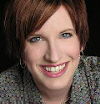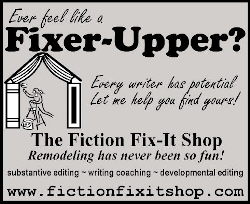
Meredith Efken is the owner of the Fiction Fix-It Shop, exclusively serving writers of adult and YA fiction. A multi-published novelist as well as freelance editor and writing coach, she is passionate about great stories and about empowering other writers to reach their full potential. Actively pursuing that desire, she started Fiction Fix-It Shop in 2006 where she has helped many fiction writers achieve their personal and professional goals. Her clients include award-winning Christian fiction authors such as Deborah Raney and Randall Ingermanson. She is also a member of the American Christian Fiction Writers as well as Word Sowers Christian Writers – a local group she has cofounded. Meredith currently lives in Omaha, Nebraska with her husband, Jason and 2 lively daughters. |
I Need Structure!!! |
Scenes are supposed to be a microcosm of the entire book...Scene structure, that is. If one thing guarantees to send a story down the meandering, dimly lit, dead-end byway of total reader apathy, it’s a poorly structured scene. You know the ones I’m talking about, right? • The one where the POV
character is mentally sizing up or describing all the other characters
in the room—like a line-up of suspects, only without even the interest
of a crime. Or what about the scene that is actually not a scene at all—just a paragraph or two describing someone or someplace, or showing some vague action that we suspect is supposed to be significant. At least we hope it will be significant at some point because at the moment it feels like an utter waste of a perfectly good tree branch. Scenes are not some arbitrary fraction of a book. They’re not there to look pretty or make an interesting pattern on the page. We are not writing blank verse poetry here! Not to denigrate blank verse—I love it. But if that’s what you want to write, do it, and you won’t have to worry about scene structure—unless you are writing an entire novel in blank verse, which is a different matter entirely. And in that case, you still need scene structure! (See, brought that tangent right around, didn’t I?) Scenes are supposed to be a microcosm of the entire book. Each one should play a vital role in the book. And by “vital” I do not mean the one tiny bit of obscure information or personality quirk that you’ve embedded in an otherwise meaningless collection of narration and dialogue. Vital means just that—if you take out that scene, your novel should be substantially altered in a way that harms the integrity of the story. If your scene doesn’t provide a crucial service to the story, then either take it out, combine it, or change it so that it works harder. As a microcosm of the whole book, scenes should reflect the same dramatic and literary structure that you are supposed to apply to the entire novel. Would you have a story without a Goal, without Conflict, without Climax or Resolution? You would never, ever consider committing such a crime against the noble novel, right? (Your cue to respond with a resounding no!) And yet, writers regularly and quite callously render the same neglect and abuse to the poor, innocent, hard-working scenes that make up their novels. Our scenes are crying out, “Give us bones! Give us tendons! We are but weak mush flopping around like fat globules—full of stored energy, but helpless to use it! Rescue us from our own flaccidity!” Seriously. That’s what they’re saying. Dramatic little buggers, aren’t they? But considering that without strong scenes our novels will be about as appealing as overcooked, day-old elbow macaroni with no cheese, we’d best be listening to them. So how do you give bones to our scenes? You start with a purpose. What is this scene supposed to accomplish in your story? It had better be more than simply introducing a character or moving characters from point A to point M, or bridging every single second from the time they wake up to the time they eat lunch. A scene has a specific purpose it must accomplish to advance the story. It’s your job to know what that purpose is. A scene also must have narration, dialogue, characters, setting, and a sequence of events. Scenic description or narrative summary does not by themselves constitute a scene. I suppose you can skip dialogue occasionally, but something must be happening to qualify as a scene. |
Scenes should have a POV (point-of-view) character who has a specific goal or dilemma for that particular scene. Yes, characters have a Story Goal, but that’s not the same as a Scene Goal. The Scene Goal is just for that scene, and it can be pretty small. But it has to be there. You also need to show that the character has a compelling reason for that goal. It can’t come across as arbitrary or random. As readers we don’t always need to know exactly what the Motivation is, but the author had better know. A goal easily reached is boring. So you need to put up barriers or complications in the scene to keep your character from achieving the goal too quickly or easily. The literary term is “Conflict,” but sometimes we try to avoid that because many people interpret that as fighting or arguing between characters. So call it Tension, Barriers, Complications, or whatever. It’s anything that makes it more challenging for the character to reach the scene goal. These complications should be arranged in ascending order—so that the tension in the scene builds and increases throughout the scene. This should create a sense of building toward something—we should feel like we’re going somewhere and that we will reach that unknown destination at some point. That point would be the climax of the scene. Again, “climax” sounds too dramatic to some people who rightly point out that their scene doesn’t need fireworks at the end. So think of it more as the apex or the point of the scene. It’s the part that makes us feel like “Okay, now I’ve arrived. Now it all makes sense. This is what I was waiting for.” You know how annoying it is when a little kid tries to tell you a joke. They ramble on for minutes and mess up the punch line or omit it entirely. Then they look at you, waiting for you to laugh, but you have to ask if they’re done before giving them a hearty courtesy laugh. Yeah, that’s like a scene without this climactic moment. Don’t do that to your reader. In story structure, the Climax is shortly followed by the Resolution, where everything is tied up and the story ends. We don’t want to do that in any scene but the final one. So instead, we resolve the scene in a way that draws the reader into the next scene. Some people call this ending on a “disaster”—which might not be as cataclysmic as it sounds. But it’s something that doesn’t go right, that makes the reader need to keep reading. The character may or may not have achieved their Scene Goal, but they find that the goal wasn’t adequate or that it was not achievable, and now they have to face the consequences of what has just happened. Or maybe they’ve arrived at a decision and it’s time to move forward. Either way, it should give the reader a feeling that this section of the story is now complete as a literary unit, but it opens the way for the story to continue. There are lots of other ways to make a scene stronger, but these are the basics of scene structure. Go ahead—apply them. Give your scenes bones. They’ll thank you, your readers will thank you, and if I ever have the chance to read your work, I will thank you. (Oh boy, will I ever!) No more flabby, oozing literary fat globules—I’m begging you! I need Structure! Thanks, as always, for listening to my rant. I think next month I’ll go off on the joys of torturing our characters. Pain, horrors, suffering . . . sound like fun? Until next time.  |







